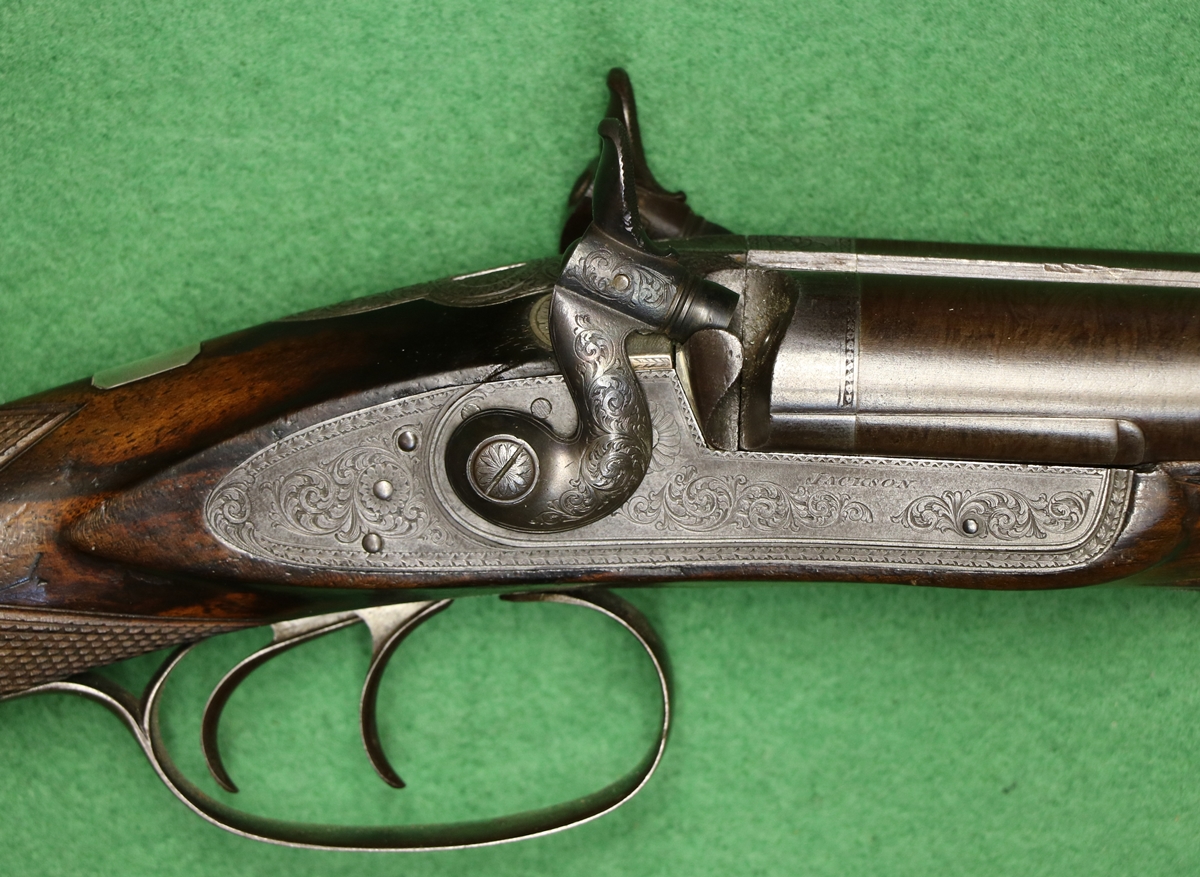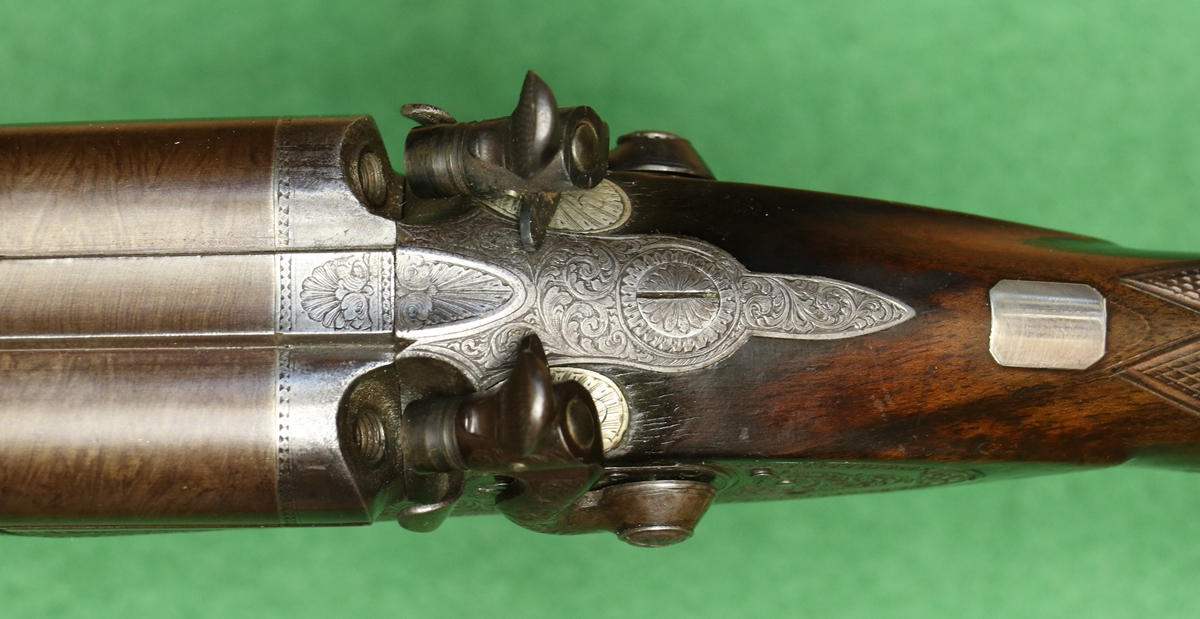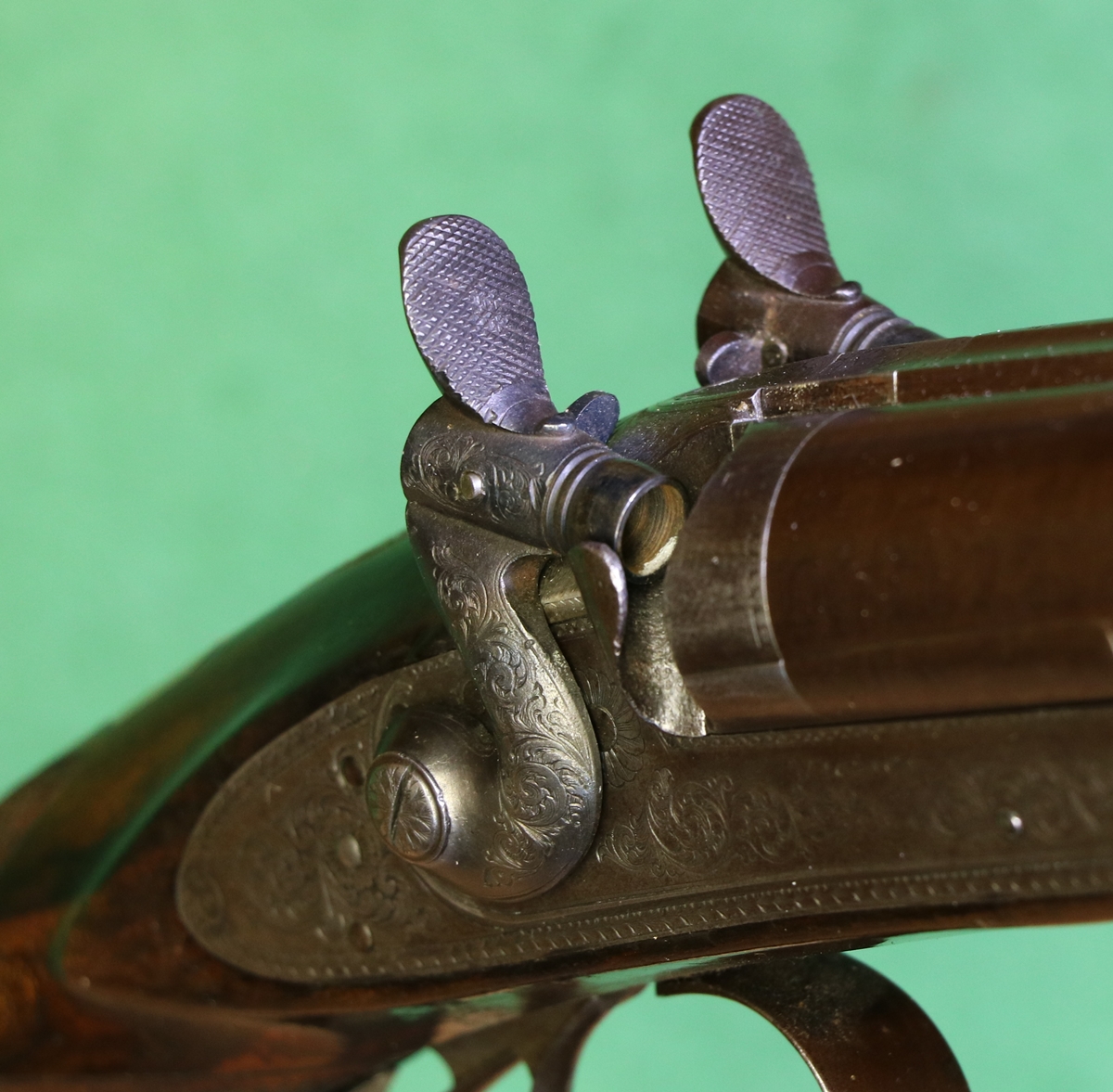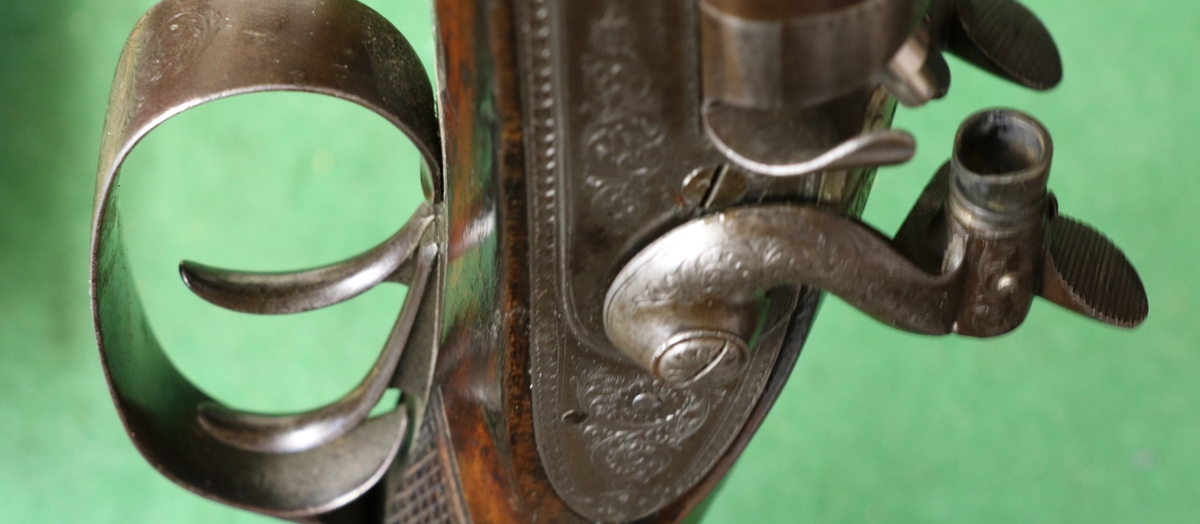This gun is a rare example of a Jackson design for a method of speeding up combustion in percussion guns by directing the fire from the cap straight into the centre of the breech block. I haven’t yet found a patent, nor do I know if one exists for this design. Given that the patent breech by Henry Nock added a secondary chamber in order to speed up ignition by setting up a small primary explosion to set off the main charge, its not clear that going straight into the breech would actually achieve what Jackson intended. One can see why he might have thought it would, because Nock’s design is counter intuitive. i look forward to trying it out – I wonder if an ordinary video camera is fast enough to capture small differences in ignition speed – I rather doubt it. Judging purely by the style, the wood and the engraving I would put this latish in the percussion era – very probably post 1840.
The photos show the gun as I acquired it without nipples – someone had replaced the noses of the cocks and discovered that they foul on the nipples as the cocks have a very small radius – so they removed the nipples so the purchaser wouldn’t notice, and sold it! that is the sort of c**p that collectors have to put up with, and why you need to be suspicious of every deviation! Fortunately it will be easy to fix by filing a small amount of the noses away on the underside.
There were several London and Birmingham gunmakers named Jackson who were in business around the time that this gun was (presumably) made, and as there is no address or initial on the gun I can’t find any way of distinguishing between them. The gun does have Birmingham proof marks under the barrel and on the breeches, which suggests Birmingham manufacture but is not a guarantee. More work needed!
A John Jackson (1845 – 1880) of of 49 Ellis Street, Exeter Row, Birmingham was advertising a a patent centre fire breech loader in 1862 so may have been the man, on the rather weak assumption that he was an inovative gunmaker.
The wood of the stock looks the sort of thing that came in around the time of the breech loader – it makes me wonder if this was the last fling of the percussion gun?
Notice the little ears on the insides of the cocks – in the firing position they shield your eyes from flying bits. Any bigger and they would interfere with the sighting.
Now fitted with titanium nipples – the skirts of the cocks just about foul the tops of the nipples, – certainly with caps on the nipples.
Sorry about the fuzziness – the bottom edge of the skirts have now been gently reshaped to clear the caps.
Next job is to raise the dents and dings in the stock and replace the shiny varnish with an oil finish! That will have to wait a bit.
When I was at the Scottish M/L championships (2017) I saw a similar gun by a maker not known to me (I’ve forgotten who) made in Scarborough (or, as usual, made in Birmingham and retailed in Scarborough) that had a lot of similarities to the Jackson, including the near central nipples and the replaceable cock mouths, but lacking the little ears on the inside of the cocks, and without any mention of the Patent. I must find out more about it – I should have taken a photo but I was more concerned with marshaling all my own equipment






I have a Jackson gun . Early half cock hammer gun . No initial no address . It has an un usual broad top lever and the engraving on that is very similar to the broad breech mount on your interesting central fire percussion gun . I’ll send a picture if I can . Roger NZ
Very interesting shotgun.
I gather many of these (rather rare) “Improved Central fire ” guns werer made by S& C Smith, of London. (B’mingham proofs may throw this, but many barrels supplied to London.)
I have a near identical gun, marked “Improved Central fire” and retailed by E Winton of Tiverton.
This makes me think they were made by the trade.
Locks on mine have nice four pin bridles and made by “J J” or Joseph Jones of Wolverhampton.
I now live in Canada, but gun was acquired back in the UK.
On this one, it still has the flared striker cups to the cock noses.
If you wish to see some photos for comparison, please Email me and I’ll send some along.
All the best,
Richard. (In Alberta )
Thanks for your interest. I’ve since seen a number of guns made to that principle late on in the percussion era, including another Jackson without the ‘rabbit’s ears’ on the hammers.
I believe that very little hot metal work was undertaken in London in the mid to late percussion era if not before. Charles Lancaster was reputed to be the last gunmaker to ‘make’ barrels in London, and he got the forgings from Birmingham. It depends on the individual gunmaker and the class of gun as to how much was done in house and how much was bought in. but most provincial and lesser London makers would probably have bought in finished guns. The sheer number of skilled men you would need to do the full range of work in making a gun would make it uneconomic for most ‘gunmakers’ to do all the work themselves in the face of the highly competitive manufacturing process in Birmingham. Another clue comes from the fact that by that period parts were often interchangable, particularly breakable parts – I’ve swapped mainsprings that fit guns from different makers perfectly, and even dropped John Manton hammers into a Samual Nock gun with the squares fitting and lining up perfectly – I still use that gun extensively and the fit has never been touched. So unless its a high class gun by one of a few makers in London, there is a good chance it is made more or less entirely in Birmingham!
see contacts page for my email address.
I’d be interested in couple of photos if its not too much trouble.
Tim
Thanks for your reply, Tim.
I am sure you are right about the late percussion gun trade, and even then very best bought in the locks from Brazier, Stanton, Grainger and so forth.
What I do find interesting re. locks, is that Boss seems to have used his own design earlier on, as these early locks do not have bridles like any others I have seen.
THank you again, and I will send an email inc. photos for you.
All the best
Richard.